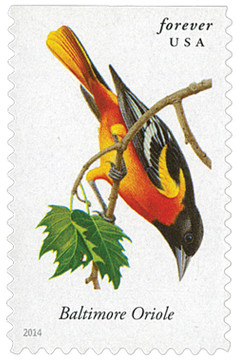
US #4882-91
2014 Songbirds
- 10 stamps picturing different species of songbird
Stamp Category: Commemorative
Value: 49¢ First Class Mail Rate (Forever)
First Day of Issue: April 5, 2014
First Day City: Dallas, Texas
Quantity Issued: 400,000,000
Printed by: Ashton Potter (USA) Ltd.
Printing Method: Offset
Format: Double-sided Booklets of 20
Tagging: Nonphosphored Type III, Overall Tagged
Why the stamp was issued: To commemorate the many species of songbirds that call America home and fill the air with the sounds of their unique tunes.
About the stamp design: Includes 10 different designs, each picturing a different species of songbird and its’ common name: western meadowlark, mountain bluebird, western tanager, painted bunting, Baltimore oriole, evening grosbeak, scarlet tanager, rose-breasted grosbeak, American goldfinch, and white-throated sparrow. In addition to the birds themselves, the stamps also picture different plants (often found in the birds’ natural habitats) acting as perches. Designs were created from paintings by Robert Giusti.
First Day City: In addition to the Dallas, Texas, First Day of Issue city, there was also a First Day of Sale ceremony held at the Philadelphia National Stamp Exposition in Oaks, Pennsylvania. They offered two different pictorial postmarks: one from Oaks and one from nearby Audubon, Pennsylvania. The pictorial cancels were designed by the American First Day Cover Society.
History the stamp represents: Nearly half of the world’s birds (about 4,000 species) are classified as passerines, or songbirds. They are typically small, migratory birds found throughout the world in a variety of habitats. We recognize them by their often-bright coloring and by their distinct songs.
The characteristic melody of a songbird is the product of its highly developed vocal organ, or song box, sometimes coupled with an elongated windpipe. Each species has its own set of songs and each bird performs its own version of those songs, varying the tone or pitch ever so slightly, so that its neighbors can identify the singer.
All vocalization by songbirds is a form of social communication, but not all songbird calls are considered songs. The songs as we recognize them are usually tunes used by males of the species in courtship and breeding, and in establishing and maintaining their territory. Females will sing on occasion and some species will even perform duets. Scientists think this may reinforce the bond of a mated pair.
For reasons yet unknown, songbirds make the best use of their vocal skills in the wee hours of the morning. Year-round, early risers appreciate the so-called dawn chorus each daybreak. In temperate climates, spring is the best time to catch the performance. It is officially recognized on International Dawn Chorus Day each May. Every year, thousands of bird lovers gather at events around the world to enjoy these beautiful songs.










